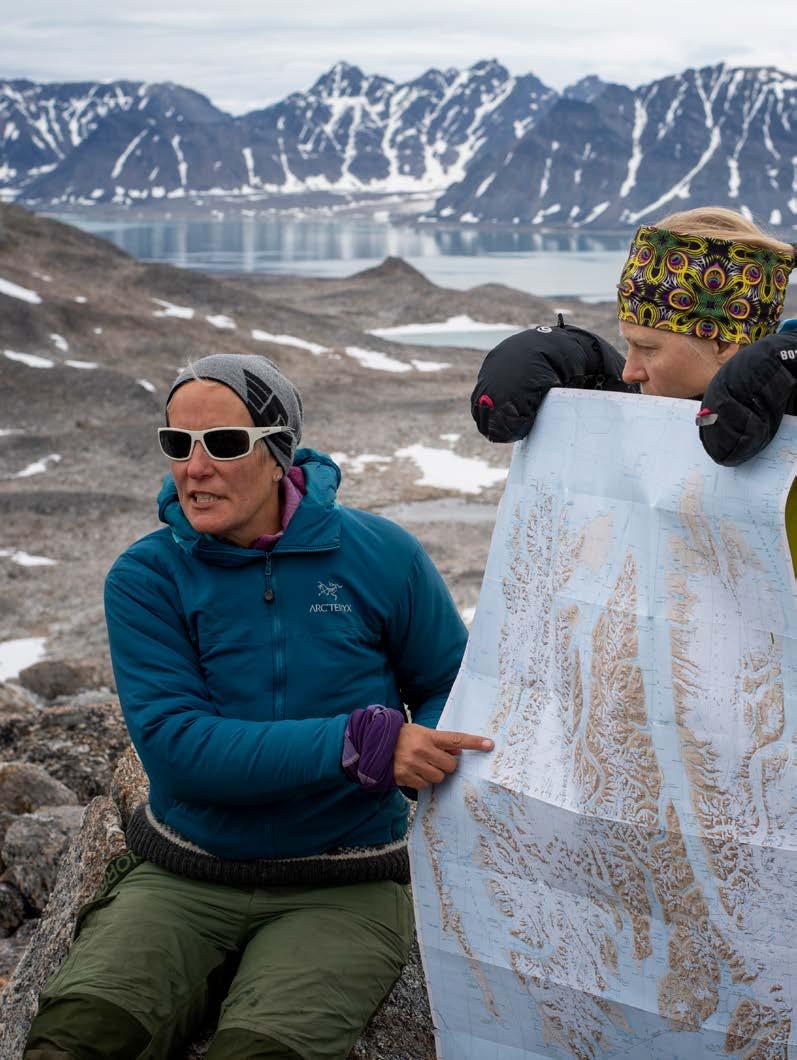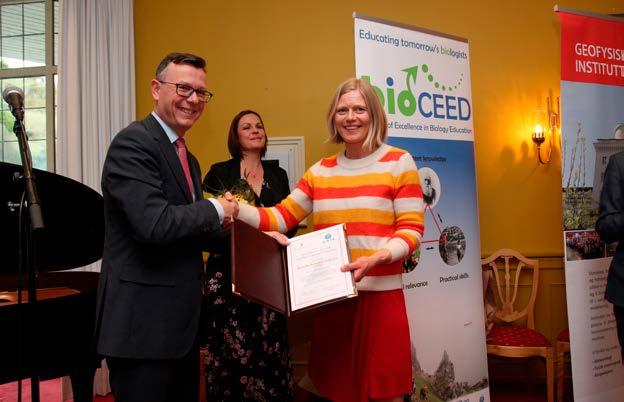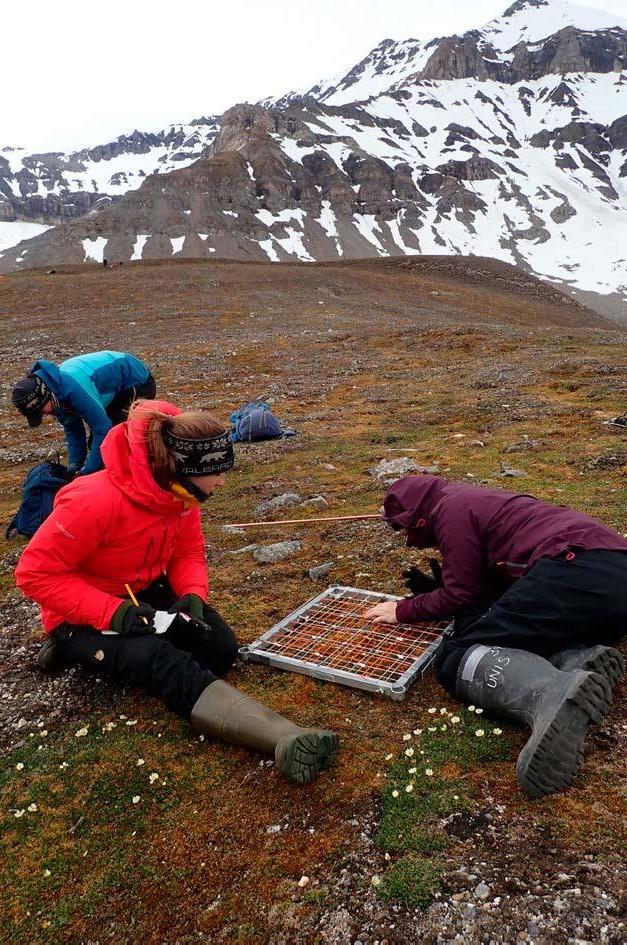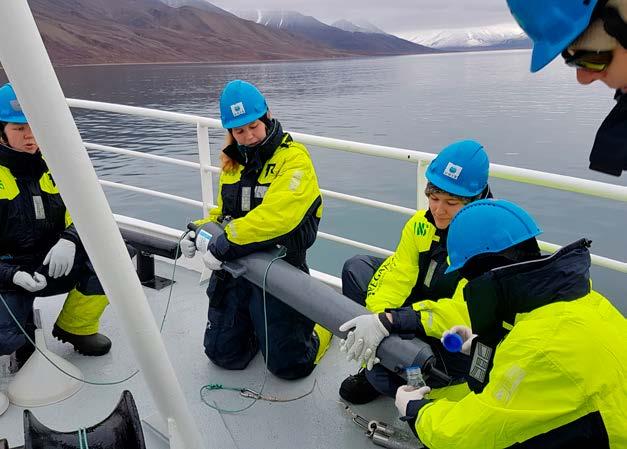
12 minute read
ARCTIC BIOLOGY
Arctic Biology (AB) provides a full one-year curriculum of undergraduate studies, as well as a range of masterand PhD level courses in biology. The department conducts research within biological climate effects, seasonality, and dynamics of species and ecosystems in space and time. Our strategy will strengthen our local, national and international scientific role, founded upon curiosity driven, high scientific competence and yearround presence in Svalbard.
At the end of 2019, the AB department consisted of three professors, four associate professors, five PhD students, two postdocs, a staff engineer and eight adjunct professors. Three new PhDs and one post doc were hired during 2019.
Advertisement

EDUCATION Our aim is to be the primary study site for learning high Arctic biology through authentic experiences. Education at AB is research-based both in knowledge content and how we teach. Knowledge and skills are best mediated through student centred active learning and authentic research settings, and active involvement creates more motivated students and aid deeper learning. Based on this background AB has now developed both a bachelor research project course (AB-207) and a bachelor internship course (AB-208). The courses give insight into research at AB and activities at external institutions that provide job opportunities after the students finish their education. This provides the students with more practical experience and generic skills that might improve learning outcomes in other courses and prepare them for later careers. The educational development in the AB department is to a large extent linked to the project bioCEED, the Centre for Excellence in Education (see separate chapter).
Our focus on educational development has also led to more research on education within the department. In 2019, the inter-departmental project FieldPass was funded by the Norwegian Agency for International Cooperation and Quality Enhancement in Higher Education (DIKU). The goal of the project is to develop and research alternative forms of assessment suitable for field related learning. FieldPass will employ one postdoc and one technician.
April 2019: Associate professor Pernille B. Eidesen was awarded status as excellent teaching practitioner (ETP). Here, she receives proof of the award from rector Dag Rune Olsen at the University of Bergen. Photo: Jens Helleland Ådnanes/UiB.

arctic, interdisciplinary field laboratory for teaching and research. To include students in field-based research activities requires more planning and resources than ordinary teaching. The goal is therefore to establish measurement stations close to Longyearbyen, for obtaining a variety of parameters, that are relevant for understanding both single components and relationships in an ecosystem. All data collected, small and large, will be available in a common database, and eventually made available through SIOS (Svalbard Integrated Arctic Earth Observing System).
In 2019 AB associate professor Pernille Bronken Eidesen received the status of excellent teaching practitioner (ETP). She was one of two candidates who were awarded the ETP out of 11 applications from UiB and UNIS. Pernille Bronken Eidesen is now part of the Pedagogical Academy and the purpose of the academy is to raise the quality of education through a collegial and collaborative teaching and learning culture.
RESEARCH The overall aim of the AB department is to become a leading institution in high Arctic biological research with cutting edge methodology and infrastructure. Our goals embrace advancing fundamental knowledge on the ecology and evolution of Arctic species, formed by seasonal as well as long-term interactions with the biotic and abiotic components characteristic of the Arctic environment, including human impact. Our research covers three over-arching interlinked themes: Climate change biology, Seasonal ecology and Spatio-temporal dynamics of species and systems.
The department is partner in numerous projects, including largescale projects that embrace several research aspects and many faculty staff. On the marine side the Nansen Legacy project (see separate chapter) was one of the departments major activities in 2019. The project has already led to several new external positions at AB.
The departmental initiative BIG (Bjørndalen Integrated Gradient) was continued and expanded in 2019. BIG is a supersite concept that includes all faculty staff and all habitats along an axis from the terrestrial site in Bjørndalen outside Longyearbyen, to the nearby shore areas and the IsA (Isfjorden-Adventfjorden) marine time series station. Both BIG and the Nansen Legacy projects are attempts at increasing cross-disciplinary collaboration within and outside the department. In addition, BIG includes both educational and research approaches, including research on didactic topics such as field education.
Examples of ongoing activities within BIG include automated monitoring of plant phenology and plantpollinator interactions with time-lapse cameras. One set of cameras monitors Dryas octopetala (Mountain avens) as part of a large circumpolar project led by Aarhus University. This project uses state-of-the-art machine learning and computer vision methods to study the role of climate in plant-pollinator interaction with unprecedented accuracy at a range of arctic field sites. Another set of cameras monitors Silene acaulis (Moss campion) to investigate how the timing of flowering and pollinator activity affects reproductive output.

This UNIS-led project has so far collected more than 3 million pictures from three different locations (Svalbard, Greenland, and mainland Norway).
Polyploidy is an important driver for evolution and speciation, particularly in the Arctic. A model system for autopolyploidy-research established in 2018 was further extended into BIG in 2019. Using Saxifraga oppositifolia (Purple saxifrage) as model species, the aim is to understand the evolutionary consequences of autopolyploidy. This model system generated two master theses and two bachelor theses in 2019.
Permafrost in arctic regions is under severe threat in times of climate change. Also, vegetation, which plays an important role in insulating soils, is expected to undergo significant changes. In 2019, several monitoring sites were established as part of BIG and in Adventdalen to record vegetation changes over time, and to study the influence of vegetation on the development of active layer depth. Sites encompass contrasting plant communities, from barely vegetated sites to well-developed moss tundra. Loggers were set out to record soil temperature and vegetation composition, including mosses which are important actors in insulating soils.
In 2019, AB initiated a seasonal reindeer project in Bjørndalen as part of BIG. We know very little of how the Svalbard reindeer seasonally use the landscape. The reindeer in Bjørndalen are counted on foot every week as well as being recorded by an automated network of time-lapse cameras. The time-lapse cameras also record snowmelt and reappearance of the vegetation. In 2019, the Bjørndalen population increased from 35 animals in March to 142 in July. The spatial distribution of the reindeer followed both snowmelt and vegetation appearance, with snowmelt being more important in the beginning of the season.
The AB department also participates annually in the capture-recapture of reindeer in Reindalen and the total count of the reindeer population in Adventdalen. Both populations have increased considerably over the last 40 years. However, the reindeer is particularly sensitive to winters with increased icing with following high winter mortality.
On the marine side acoustic mapping of the nearshore bottom topography and macroalgae coverage was conducted in 2019 by use of Norbit integrated wideband multibeam sonar (iWBMS) 200-700kHz. In March, AB students filmed underwater and dredged for macroalgae to study the habitat type and the kelp biodiversity in Bjørndalen.
The IsA (Isfjorden-Adventfjorden) marine time series station high-resolution marine time series station is the marine endpoint of the BIG gradient. The station was established in 2011 and aims to determine temporal drivers of microbial and zooplankton communities and to monitor and predict climate induced ecosystem changes. Time-series stations, such as IsA, are essential in telling apart natural year to year variation and long-term climate related alterations. Data on hydrography as well as diversity and community composition of microbial eukaryotes and larger plankton is collected monthly. Analyses of biological data from multiple years show both recurring seasonal patterns of biodiversity and species composition, as well as large interannual variation linked to inflow of “warm” Atlantic water. The bacterial communities at IsA were included in the time-series in 2019, as part of an ongoing master thesis.
To obtain a more holistic understanding of the “sea climate” in Isfjorden, AB also surveys the deeper marine station IsK (Isfjorden-Karlskronadjupet) located in the middle of Isfjorden. Here, PhD student Maja Hatlebakk did a monthly study for an entire year in 2015-2016 on the population development and physiology of the key zooplankton species Calanus glacialis and C. finmarchicus which are regarded as climate indicator species for Arctic and Atlantic Waters respectively. Maja defended her PhD successfully in November 2019 and her interesting findings have motivated UNIS to continue monitoring the IsK marine station.
Arctic coastal ecosystems are changing as climate changes and human activities increase. Thus, government managers, industries, conservation organizations and communities need timely biodiversity and ecosystem status data and, if possible, plausible projections of status of biodiversity and ecosystem services over the next decades. The AB focus on coastal ecosystems has led to several new projects which UNIS leads or is a major partner of.
The NIVA led project TerrACE - Where land meets sea: Effects of terrestrial inputs on contaminant dynamics in Arctic coastal ecosystems (NRC 2017-2020), studies riverine impacts on Isfjorden with high spatial resolution during the summer season. It includes studies of hydrography and physical properties, plankton, benthos, food webs and pollutants (mercury and POPs). The intensive and demanding field work conducted in summer 2018 resulted in six successful master theses graduations in 2019 of which four were UNIS AB guest master students. In 2019, an add-on project entitled FreshFate: Freshwater inputs to Svalbard’s coastal waters: Fluxes, fate, and implications for coastal ecosystems (Fram Centre 2019-2021, also led by NIVA) was initiated with two new master students involved.
Thelarge international project ACCES - De-icing of Arctic Coasts: Critical or new opportunities for marine biodiversity and ecosystem services (Biodiversa and Belmont forum) officially started in 2019. ACCES comprises a strong panArctic and multidisciplinary team from Norway, Poland, Canada, USA and Denmark, and is coordinated and led by UNIS. This project will synthesize existing environmental and biodiversity data and generate new knowledge from sites spanning over a wide geographical scale from the Pacific to the Atlantic Arctic. In 2019, spring sea
September 2019: AB-332/832 students collecting water samples from a Niskin bottle. Photo: Malene Strøm Dieseth.

ice sampling was conducted in Van Mijenfjorden and at the East Coast (Inglefieldbukta), summer plankton biodiversity was examined during several cruises with Hurtigruten (see below) and a dedicated ACCES cruise to Storfjorden, where also macroalgae vegetation was mapped using acoustics.
Spatial resolution in biodiversity on the west and east coast of Svalbard was also addressed using Hurtigruten´s expedition ships during 2018 and 2019. This was a part of a citizen science projects funded by the Svalbard Environmental Protection Fund, where participants from AB gave lectures and demonstrations for the tourists on board, in addition to collecting marine biological data. Data collected during the 2018 Hurtigruten cruises resulted in a successful master thesis in 2019.
All these coastal initiatives led to participation in the large EU proposal FACE-IT: The future of Arctic coastal ecosystems - Identifying transitions in fjord systems and adjacent coastal areas. This project, led by Bremen University, was funded in 2019 and will officially start in 2020.
The FAABulous project: Future Arctic Algae Blooms – and their role in the context of climate change (RCN 2015- 2019) ended in 2019, with the successful defence of the PhD thesis of Ane Cecilie Kvernvik. The FAABulous project studied the combined effects of altered light conditions, ocean acidification and invasion of temperate species on Arctic pelagic and sympagic algal blooms.
October 2019: AB-332/832 students working in the UNIS teaching lab. Photo: Mads Schultz.


GRADUATES 2019
PHD DEGREES:
MAJA KAROLINE VIDDAL HATLEBAKK
New insights into Calanus glacialis and C. finmarchicus distributions, life histories and physiology in highlatitude seas. (UNIS, Nord University and Alfred Wegener Institute).
MASTER DEGREE:
MAGNUS HEIDE ANDREASEN
Community composition, population structure and phylogeny of coastal sympagic meiofauna in eastern Svalbard. (University of Bergen and UNIS).
ANGELINE J.H.M. BRULS
Speciation in spe: Do cytotypes in Saxifraga oppositifolia L. (Saxifragaceae) in Svalbard differ in dispersal efficiency? (Wageningen University & Research and UNIS).
NATHALIE CARRASCO
Seasonality in mercury bioaccumulation in particulate organic matter and zooplankton in a river-influenced Arctic fjord (Adventfjord, Svalbard). (The Arctic University of Norway, NIVA and UNIS).
BEC DUNCAN
Arctic herbivore success in a changing climate. (Murdoch University and UNIS).
EIRIK AASMO FINNE
Flux of nutrients and mercury from an Arctic seabird colony to the coastal food web. (University of Oslo and UNIS).
LOUISE C. FLENSBORG
Mammal conservation status in a changing Arctic. (University of Copenhagen and UNIS).
EGIL LILLEHAUG
Environmental correlates of variation in a holistic analysis of annual offspring production in the high Arctic songbird snow bunting (Plectrophenax nivalis) on Spitsbergen. (NTNU and UNIS).
MARGOT U. NYEGGEN
Seasonal zooplankton dynamics in Svalbard coastal waters: The shifting dominance of mero- and holoplankton and timing of reproduction in three species of Copepoda. (University of Bergen and UNIS).
KIRSA NØRREGÅRD
A metabarcoding study on community composition of marine microbial eukaryotes in the waters around Svalbard (The Technical University of Denmark (DTU) Aqua and UNIS).
ANE CECILIE KVERNVIK
Ecophysiological responses of sea ice algae and phytoplankton to a changing Arctic. (UNIS, The Arctic University of Norway and Akvaplan-niva).
HELENE PAPE PEDERSEN
Conservation status of seabirds at Svalbard. (University of Copenhagen and UNIS).
VANESSA PITUSI
Seasonal abundance and activity of sympagic meiofauna in Van Mijenfjorden, Svalbard. (The Arctic University of Norway and UNIS).
ALOÏS REVÉRET
Evolutionary consequences of autopolyploidy Have a shift in substrate preferences expanded the niche of Saxifraga oppositifolia L.? (Savoie Mont Blanc University and UNIS).
STINA LINNEA EMELIE SKOGSBERG
Effects of seasonal riverine run-off on contaminant accumulation in Arctic littoral amphipods (University of Oslo, Akvaplan-niva and UNIS).
CHRISTIAN STOLZ
The nestling diet of Svalbard snow buntings identified by DNA. (The Arctic University of Norway and UNIS).
VERA TEUNISSE
Plant growth and phenological development of native plants on Svalbard in shelter. (Vrije University Amsterdam and UNIS).
CHARLOTTE PEDERSEN UGELSTAD
Riverine and glacier influence on infaunal benthic communities in Isfjorden, Svalbard. (The Arctic University of Norway, NIVA, Akvaplan-niva and UNIS).
KRISTINE VALØEN
Stochastic rain events increase NDVI through moss water content: A High-Arctic field experiment. (NTNU and UNIS).










